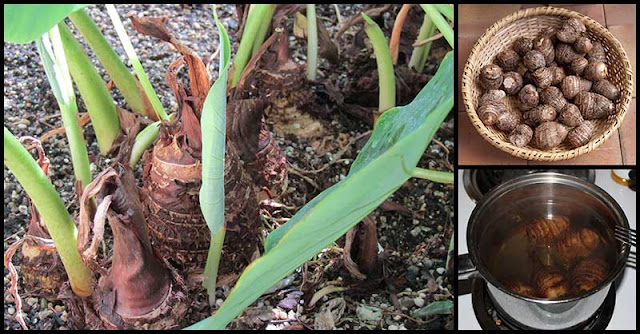According to various studies, there are several factors that may cause cancer. These include bacteria and viruses, genetics, UV radiation in sunlight, tobacco, alcohol, unhealthy environment, and unhealthy modern lifestyle. Yes, it’s true that fighting cancer is not an easy battle. That’s why, as much as possible, we’d want to protect ourselves from this deadly disease. When it comes to cancer prevention, we do have lots of options and one of them is by regular consumption of Taro root.
Taro root is the tuber stalk of the taro plant which is considered to be the first cultivated plants in human history. The leaves, roots, and corms of this plant are being used as dietary ingredients but it must be cooked before consumption.
Nowadays, taro roots have been gaining popularity in certain health-conscious cultures and populations. Found in these thick roots are organic compounds, minerals, and vitamins that benefit our overall health in a number of ways. It is packed with vitamin A, B6, C, and E, as well as significant amounts of dietary fiber and carbohydrates. Aside from this, Taro roots also have generous amounts of copper, iron, magnesium, manganese, potassium, phosphorus, and zinc, as well as small amounts of protein.
One cup (132 grams) of cooked taro has 187 calories — mostly from carbs — and fewer than one gram each of protein and fat.
It also contains the following:
- Fiber: 6.7 grams
- Copper: 13% of the DV
- Vitamin B6: 22% of the DV
- Vitamin E: 19% of the DV
- Vitamin C: 11% of the DV
- Manganese: 30% of the daily value (DV)
- Magnesium: 10% of the DV
- Potassium: 18% of the DV
- Phosphorus: 10% of the DV
Reasons Why Taro Root Can Help Lower Our Cancer Risk
Contains Potent Antioxidants
Present in taro roots are polyphenols and potent antioxidants that can strengthen our immunity and protect our body from excessive free radical damage that has been linked to cancer. According to the US Department of Health and Human Services, free radicals are the dangerous by-products of cellular metabolism that can cause healthy cells to mutate and turn into cancerous cells. In a report published by the American Institute for Cancer Research, it was found the taro root contains cryptoxanthin which has the ability to lower the chance of developing both lung and oral cancers.
Good for Our Gut
Present in Taro roots is fiber and resistant starch which are beneficial in gut health. These two serves as food for the microbes in our gut. Once they are fermented by the gut bacteria, they create short-chain fatty acids that may protect against stomach cancer, colon cancer, and inflammatory bowel disease.
Contains Anti-Inflammatory Properties
Studies revealed that Taro root contains powerful anti-inflammatory properties that help reduce inflammation associated with several health conditions including cancer.
Excellent Source of Vitamin E
Since the Taro root is packed with vitamin E, it can significantly lower our risk of cancer. Vitamin E works by promoting cell regeneration and preventing cell mutation. Some other foods rich in vitamin E are spinach, broccoli, almonds, and peanuts.
High in Vitamin C Content
High amounts of vitamin C is present in each serving of taro root. This vitamin helps stimulate our immune system to create more white blood cells that will defend our body against foreign pathogens and agents. It also acts as an antioxidant that helps us lower our risks for serious health conditions such as cancer.
Packed with Soluble Fiber
The soluble fiber in the Taro root is the one responsible for its starchy texture. Fiber aid in healthy digestion maintains bowel health and normalizes bowel movements. According to studies, a high-fiber diet likely lowers the risk of colorectal cancer.
Cholesterol-balancing Effect
Taro root has an amazing cholesterol-balancing effect. Its fibers work by binding with bad cholesterol inside the intestine and wash it away from our body.
Excellent Source of Simple Carbohydrates
Carbohydrate is an energy booster. Simple carbs digest faster, which helps bring our blood sugar and glycogen levels back to normal faster than eating complex carbs.
Low in Calories
Since cancer cells require nutrients to grow, a diet low in calories will make them starve thereby inhibiting their development.
How To Consume Taro Roots
Taro tea: Blend taro or use taro powder, blend it with milk, and top-of with pearls.
In soups and stews: Cut taro into chunks and use in brothy dishes.
Mashed taro root: Simply peel and steam the root and then mash it, gradually adding water until it’s smooth and sticky.
Taro pancakes: Incorporate taro powder in pancake batter to create fluffy hotcakes.
Taro chips: Thinly slice taro and bake or fry into chips.
Taro cakes: Mix cooked taro with seasonings and pan fry until crispy.
Hawaiian poi: Steam and mash taro into a purple-hued puree.
Taro buns: Bake sweetened taro paste inside buttery pastry dough for dessert.
Important Reminder
Taro root should only be eaten cooked. Avoid eating raw Taro as it contains proteases and oxalates that can cause a stinging or burning sensation in your mouth.









